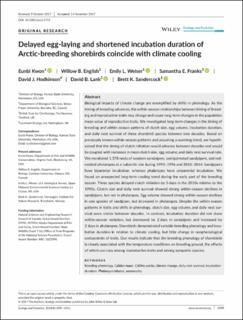Delayed egg‐laying and shortened incubation duration of Arctic‐breeding shorebirds coincide with climate cooling
Kwon, Eunbi; English, Willow B.; Weiser, Emily L.; Franks, Samantha E.; Hodkinson, David J; Lank, David B.; Sandercock, Brett
Peer reviewed, Journal article
Published version

Åpne
Permanent lenke
https://hdl.handle.net/11250/3068532Utgivelsesdato
2018Metadata
Vis full innførselSamlinger
- Publikasjoner fra CRIStin - NINA [2364]
- Scientific publications [1392]
Sammendrag
Biological impacts of climate change are exemplified by shifts in phenology. As the timing of breeding advances, the within- season relationships between timing of breed-ing and reproductive traits may change and cause long- term changes in the population mean value of reproductive traits. We investigated long- term changes in the timing of breeding and within- season patterns of clutch size, egg volume, incubation duration, and daily nest survival of three shorebird species between two decades. Based on previously known within- season patterns and assuming a warming trend, we hypoth-esized that the timing of clutch initiation would advance between decades and would be coupled with increases in mean clutch size, egg volume, and daily nest survival rate. We monitored 1,378 nests of western sandpipers, semipalmated sandpipers, and red- necked phalaropes at a subarctic site during 1993–1996 and 2010–2014. Sandpipers have biparental incubation, whereas phalaropes have uniparental incubation. We found an unexpected long- term cooling trend during the early part of the breeding season. Three species delayed clutch initiation by 5 days in the 2010s relative to the 1990s. Clutch size and daily nest survival showed strong within- season declines in sandpipers, but not in phalaropes. Egg volume showed strong within- season declines in one species of sandpiper, but increased in phalaropes. Despite the within- season patterns in traits and shifts in phenology, clutch size, egg volume, and daily nest sur-vival were similar between decades. In contrast, incubation duration did not show within- season variation, but decreased by 2 days in sandpipers and increased by 2 days in phalaropes. Shorebirds demonstrated variable breeding phenology and incu-bation duration in relation to climate cooling, but little change in nonphenological components of traits. Our results indicate that the breeding phenology of shorebirds is closely associated with the temperature conditions on breeding ground, the effects of which can vary among reproductive traits and among sympatric species.
